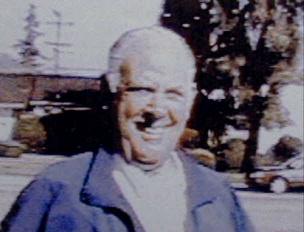Think back now. When you were young, do you or your friends ever remember going out in the country or the desert, eagerly finding some old bottles laying around, quickly lining them all up on a hill, stepping back about a hundred feet, line up the rifle or bee-bee gun and go at it? And within a few minutes the fun was all over. Rudy Kuhn used to do this too when he was young, except now he regrets it. Not because he splattered glass pieces all about, but because those bottles he shot at would probably be worth a mint today, had they still be in one piece. About 20 years ago, Rudy and his wife Terry, took a trip to the Gold Country. While taking in some antique shopping in Amador City, looking for a gift, he walked in one shop that would change his life forever. As he stepped inside, he noticed a shelf of Cobalt Blue Bottles. Looking at them all very closely, lured by interesting shapes, color and uses, they once possessed, he asked his wife, "Which one should we get? After very little deliberation, they both decided, "Let's get all nine of them!" The owner of the shop then sold them a book for $1.00 on "Poison Bottles". SOLD! back at their hotel, during Cocktail hour, the book drew Rudy in deeper. The more he read, the more fascinated he became by these "Poison Bottles".
Once he returned back home, he quickly found out about the San Jose Bottle Club, joined up and found himself attending bottle shows whenever he could. This new fascination with Poison Bottles got him up to the Chico show, where he bought 52 Poison Bottles. How do we keep track of all these? Photography? No, not enough detail was captured. But being the engineer that he is, he decided to draw the bottle details instead, and kept a detailed log of what he had, which worked out great! In 1985,a major collector friend, from out of town, came over and noticed his log, now a BOOK, holding 700 to 800 Poison Bottles! She insisted he run her off a copy of the book before she left for home. While on her way home, she stopped off at some bottle collectors and showed them the copy of the book. With immediate interest, they started calling Rudy for a copy also. He got so many calls, that he actually thought about publishing the book, but it was going to be very expensive. So he stuck to just making copy's as the requests came in. What made the book so intriguing to bottle collectors was Rudy's personal way of coding his bottles, to make it easier for him to classify and track his bottles. Mainly the shape of the bottle, color and the embossing on the bottles having been coded.
This book is in who knows how many library s and company s around the world - All because of this code he devised. This "Bottle Communication" is even used at auctions - All throughout the world, this coding system is used, known as the "Workbook".
Unlike most whiskey bottles, etc., most of the poison bottles aren't dug. They mainly come out of old barns or homes where they have been put away for safe keeping and then forgotten. The really unique ones are from the 1860's up to the 1920's. When you look for a unique bottle, they have to have a certain shape, texture and color that is specifically identifiable as "Poison". Some have an embossed coffin shape on the bottle, or the typical cross-bones, along with many other interesting embossed signs. Their colors come in Green, Brown, and Amber, but mainly the Cobalt Blue was used, defined by the early regulation/rules. Interestingly enough, it was Not regulated by the Government, but by the American / British Medical Association. The Government didn't get involved until 1906 with the drug act.
Rudy still attends shows, but not to buy, but to now sell his found treasures. He displays his bottles proudly throughout his house on glass shelves. He speaks to collectors from all over the world and to people of all walks of life, such as doctors, lawyers, Indian Chiefs (ok, maybe not Indian Chiefs) - But people he would have never had a chance to have contact with before and many wonderful friendships that would never had been made.
But what about your Metal Detecting Hobby Rudy? A friend Joe Braga, Treasure Hunter/Digger said to him one day, "Rudy, you should get into metal detecting". Off they went to Santa Cruz Beach and Boardwalk to give it a try. 10 years later, he's still part of the Santa Clara County Treasure Hunting Club, and not only a member, but loves being on the Board of Directors and planning our treasure hunts throughout the year. Being truly involved in the Club is what makes it all worth while, and once again the neat relationships that are built, started by a common hobby. Last but not least Rudy, what's your best find? Coin = an 1800's $10.00 Gold Piece in a bezel, found in a soccer field. Jewelry = a gold ring with four 10pt Diamonds. In the 10 years he's detected, he's found 110,000 coins totaling $8,000.00!
Thanks Rudy for sharing your story!

